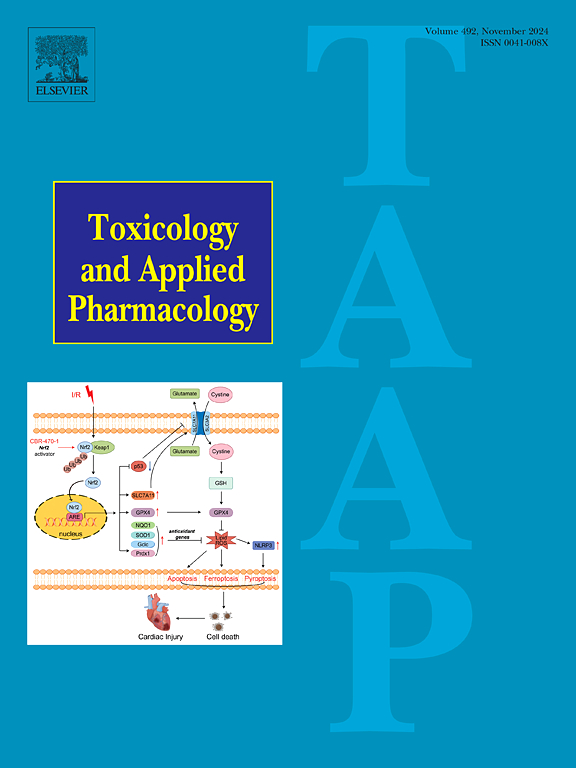NLRP3炎性体通过调节肠道微生物群的丰度来调节阿霉素诱导的心脏毒性。
IF 3.3
3区 医学
Q2 PHARMACOLOGY & PHARMACY
引用次数: 0
摘要
阿霉素(DOX)是一种广泛使用的蒽环类药物,其剂量依赖性心脏毒性限制了其临床疗效。然而,其毒性机制,特别是涉及nod样受体蛋白3 (NLRP3)炎症小体-肠-心轴的调控网络,仍然不完全清楚。本研究旨在建立多柔比星诱导的心脏毒性(DIC)的细胞和动物模型,并研究炎症小体在DIC相关的肠道微生物群丰度改变中的作用。用浓度为1、10、25和50 μmol/L的DOX处理大鼠心肌细胞(H9c2细胞),以评估剂量依赖性心脏毒性。在体内,C57BL/6 J和NLRP3/MLKL/RIPK3敲除(KO)小鼠给予DOX(5 mg/kg,静脉注射,每2 天注射3次,累计15 mg/kg)建立DIC模型。采用全自动生化分析仪测定小鼠外周血的生理生化参数。此外,我们使用逆转录聚合酶链反应量化炎症因子的mRNA表达水平,并观察心肌细胞凋亡。收集各组粪便样本进行16S重组DNA测序,分析肠道菌群。dox诱导的H9c2细胞损伤和炎症因子释放激活了NLRP3炎性体,上调了自噬相关蛋白LC3I/II。NLRP3 KO减轻dox诱导的心脏损伤,调节小鼠血液中的免疫环境,减轻DIC。NLRP3 KO降低嗜粘蛋白嗜粘蛋白阿克曼氏菌的丰度,抑制DOX的心脏毒性作用。DOX的心脏毒性作用是通过NLRP3炎性体介导的。NLRP3炎性小体可能通过调节肠道嗜黏液阿克曼氏菌的丰度介导DIC。本文章由计算机程序翻译,如有差异,请以英文原文为准。
NLRP3 inflammasome regulates doxorubicin-induced cardiotoxicity by modulating the abundance of gut microbiota
Doxorubicin (DOX) is a widely used anthracycline whose dose-dependent cardiotoxicity limits its clinical efficacy. However, the mechanisms underlying its toxicity, particularly the regulatory network involving the Nod-like receptor protein 3 (NLRP3) inflammasome-gut-heart axis, remain incompletely understood. This study aimed to establish cellular and animal models of doxorubicin-induced cardiotoxicity (DIC) and investigate the role of the inflammasome in DIC-associated alterations in gut microbiota abundance. Rat cardiomyocytes (H9c2 cells) were treated with DOX 1, 10, 25, and 50 μmol/L concentrations to assess dose-dependent cardiotoxicity. In vivo, C57BL/6 J and NLRP3/MLKL/RIPK3 knockout (KO) mice received DOX (5 mg/kg, intravenous, every 2 days for 3 doses, cumulative 15 mg/kg) to establish a DIC model. We measured the physiological and biochemical parameters of mice peripheral blood using an automatic biochemical analyzer. Additionally, we quantified the mRNA expression levels of inflammatory factors using a reverse transcription polymerase chain reaction and observed cardiomyocyte apoptosis. Fecal samples were collected from each group for 16S recombinant DNA sequencing to analyze gut microbiota. DOX-induced H9c2 cell damage and inflammatory factor release activated the NLRP3 inflammasome and upregulated autophagy-associated proteins LC3I/II. NLRP3 KO attenuated DOX-induced cardiac damage, modulated the immune environment in mouse blood, and mitigated DIC. NLRP3 KO lowered the abundance of mucinophilic Akkermansia muciniphila and suppressed the cardiotoxic effects of DOX. The cardiotoxic effects of DOX were mediated via the NLRP3 inflammasome. NLRP3 inflammasome may mediate DIC by regulating the abundance of gut Akkermansia muciniphila.
求助全文
通过发布文献求助,成功后即可免费获取论文全文。
去求助
来源期刊
CiteScore
6.80
自引率
2.60%
发文量
309
审稿时长
32 days
期刊介绍:
Toxicology and Applied Pharmacology publishes original scientific research of relevance to animals or humans pertaining to the action of chemicals, drugs, or chemically-defined natural products.
Regular articles address mechanistic approaches to physiological, pharmacologic, biochemical, cellular, or molecular understanding of toxicologic/pathologic lesions and to methods used to describe these responses. Safety Science articles address outstanding state-of-the-art preclinical and human translational characterization of drug and chemical safety employing cutting-edge science. Highly significant Regulatory Safety Science articles will also be considered in this category. Papers concerned with alternatives to the use of experimental animals are encouraged.
Short articles report on high impact studies of broad interest to readers of TAAP that would benefit from rapid publication. These articles should contain no more than a combined total of four figures and tables. Authors should include in their cover letter the justification for consideration of their manuscript as a short article.

 求助内容:
求助内容: 应助结果提醒方式:
应助结果提醒方式:


